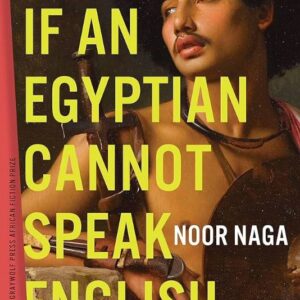In her experimental novel, “If an Egyptian Cannot Speak English,” Noor Naga transports the reader to post-revolution Egypt. A sense of disillusionment and bitterness trail behind Egyptian civilians as they awaken from the collective trance the series of protests and uprisings of 2011 brought forth. The dream of economic justice and equity alongside Egyptians’ innocence and naivety erode, and the novel brings the audience to six years post the 2011 Revolution. The Egyptian pound is worth a third of its 2011value. The foreigners left alongside “their work and their money and their drugs” (p. 19). Most Egyptians, at least those who could, fled their motherland, abandoning their hopes of rebuilding the country. However, some, as in the case of the novel’s protagonist, returned to Egypt, the land of their ancestral roots and cultural heritage. Despite the country’s wealth disparity and economic turmoil, the American girl with the shaved head left New York for Cairo. She eventually meets the unnamed tall boy from Shobrakheit, and the two share a romance of inevitable doom. “If an Egyptian Cannot Speak English” examines a destructive relationship unveiling the power structures hidden in identity politics.
Noor Naga begins the novel in Shobrakheit, a village 140 kilometers from Cairo. A mother split a single peach among a family of four, carefully slicing the ripe delicacy with a carving knife. The grandmother gathered the slices of peach and stuffed them into her ears. She then raced into the kitchen, climbing into the stove and ending her life. They buried her the next day with her collection of paper cranes. Her grandson left the village and moved to Cairo. During the Arab Spring, the boy from Shobrakheit captured the revolution with his digital camera, selling his work to Western media companies like CNN, Reuters, and BBC. Six years later, the boy from Shobrakheit keeps a “grimy analog camera” dangling around his neck, although he has not taken a picture since the end of the revolution.
The American girl would often ask why the boy from Shobrakheit refused to photograph Cairo, unable to grasp how the 2011 revolution haunts every corner of the city. He cannot capture the streets that carry the same asphalt stained with the blood of his fallen comrades. The American girl arrived in Cairo in the “riskless aftermath,” witnessing the events of the Arab Spring through the television of her home in the Upper West Side. Although she desperately wants to plead, “Me too, I’m one of you,” the American girl does not share the same memories of revolution and disillusionment that bonds the civilians of Egypt together. Nevertheless, the American girl, the daughter of Egyptian immigrants who embraces a shaved head for the aesthetic, returned to the motherland six years following the revolution, abandoning her life in New York for the “simplicity” of life in Cairo.
“If an Egyptian Cannot Speak English” is split into three parts. The first part familiarizes the audience with the novel’s two protagonists, the American girl and the boy from Shobrakheit, illustrating their childhood and family life and tracing how they came to be in Cairo. Each chapter within the section alternates between the perspectives of the two characters, headling the chapters with rhetorical questions like “How far can you run from home before you run out of water?” or “When is a confession of addiction not a foreshadowing?” It details the American girl and boy from Shobrakheit’s initial meeting. It happened during one of her frequent visits to Café Riche. She was learning how to play backgammon with her friends Reem and Sami when he walked in and plunged into the seat right next to her. The boy from Shobrakheit was immediately infatuated. The rest of the section guides the reader through their gradual romance.
The second part narrates the relationship’s ultimate demise. Noor Naga experiments with footnotes in this section, offering more context to cultural references. The boy from Shobrakheit, who developed a drug addiction during the Arab Spring, turns to substances. Unable to afford rent, he spends his days at the ahwa, Arabic for coffeehouse, and nights sleeping at the mosque. He loses himself in toxic daydreams of rescuing the American girl from other men and winning her back into his life. The American girl spends her days at work, teaching English at the British Council, meeting with co-workers, and at Café Riche with Reem and Sami. Although she remains in Cairo, she returns to the comfort of the English language “as if to the arms of a lover” (p. 100). The American girl and boy from Shobrakheit eventually reunite, and the section concludes with the tragic demise of one of the characters.
The final section features a screenplay involving students workshopping a character named Noor’s writing. It breaks the fourth wall, revealing the previous two sections are components of Noor’s memoir.
“If an Egyptian Cannot Speak English” navigates through themes of toxic masculinity in the Arab world and the sense of belonging within diasporic communities. It addresses the power dynamics between the elite and second-class citizens, approaching issues of gender and class. Noor Naga explores different literary devices in this experimental novel to compose a book on love, power, and abuse in the heart of Egypt, ultimately tackling the question: “If an Egypitan cannot speak English, who is telling his story?”
Discussion Questions:
- Discuss the two protagonists. Do you believe either fit the stereotypical description of a villain or a hero?
- What did you think of Noor Naga’s writing? How do you think the different literary devices impact the story?
- In the first part, Noor Naga begins each chapter with a rhetorical question. Discuss and attempt to respond to one of the questions.
- What did you think of the ending? What is the significance of ending the novel with a writing workshop between multiple non-Arab characters?


